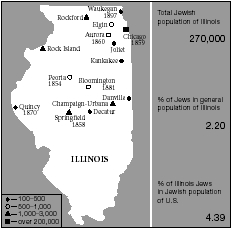Illinois
ILLINOIS, Middle West state of the U.S.; general population 12,713,634 (est. 2004), Jewish population 280,000, all but 20,000 of whom lived in and around Chicago. Early land-development companies included Jewish partners resident in the East. However, the first known permanent Jewish resident was John Hays, grandson of an early New York Jew, who settled in Cahokia in 1793. Farmer, trader, and soldier, Hays served as the county's postmaster until 1798, when he was appointed sheriff. The only other Jew known to have been in Illinois before it became a state in 1818 was Joseph Phillips, a veteran of the War of 1812, who was named secretary of Illinois Territory in 1817. The most prominent Jew in the early days of Illinois was Abraham Jonas, who moved to Quincy in 1838 from Cincinnati, Ohio. In 1842 he was elected to the Illinois legislature, where he met Abraham Lincoln, of whom he became a lifelong friend and political ally. Another early Jewish settler outside of Chicago was Captain Samuel Noah, the first Jewish graduate of West Point, who taught school at Mount Pulaski in Logan County in the late 1840s.
Jews first settled in Chicago in the 1830s. The oldest Jewish community outside of Chicago is Peoria, where the first Jews arrived in 1847. A benevolent society was organized in 1852 and the first congregation, Anshai Emeth, was formed in 1859. Jews settled in Springfield around 1850. The first arrivals were Julius, Edward, and Louis Hammerslough, merchants, whose firm was established in 1855. One of their employees was Samuel Rosenwald, who was born in Springfield in 1862 (see Rosenwald) and was the father of Julius Rosenwald, the mail-order tycoon and philanthropist. Julius Hammerslough was a friend of Lincoln, whom he visited often at the White House. He was also the first president of Springfield's first synagogue, Brith Sholom, founded in 1858. Jews first went to Cairo in 1863 during the Civil War, when the town was the headquarters of General Ulysses S. Grant. Jewish settlers named Oppenheimer and Abendheimer were the pioneers, followed
 Jewish communities in Illinois, with date of establishment of the first synagogue. Population figures for 2001.
Jewish communities in Illinois, with date of establishment of the first synagogue. Population figures for 2001.
by A. and David Marks. There were also Jews in Rock Island in the 1850s. Other early Jewish settlements were at Aurora, 1860; Moline, 1866; Bloomington, 1875; East St. Louis, 1888; Granite City, 1891; Centralia, 1894; and Waukegan, 1897.
The first B'nai B'rith Hillel Foundation was established at the University of Illinois in Urbana in 1923 by Rabbi Benjamin F. Frankel, whose family was among the Jewish pioneers of Peoria. By 1960, 40% of the families in Niles Township (Skokie and surrounding areas) were Jewish. The Niles Township Jewish Congregation, founded in 1959, was the first of what soon became a network of Jewish communal and religious institutions in the area, including a Jewish community center. The town of Park Forest, a southern Chicago suburb, whose Jewish settlement began in the 1950s, was the first large community ever planned by private enterprise. Philip M. Klutznick was president of the company that developed it. Many other suburbs of Chicago also have substantial Jewish communities, most of their members having moved from Chicago itself. The earliest communities dating from the 1930s are Winnetka, Glencoe, Highland Park, Evanston, and Oak Park. By the late 1960s there were at least 16 other suburban communities.
Beyond the Chicago metropolitan area the Jewish population in the mid-1990s of Champaign-Urbana was approximately 1,500, of Springfield was approximately 1,060, of Rockford was approximately 1,000, of Peoria was approximately 1,000, of Elgin was approximately 600, of Aurora was approximately 500, of Waukegan was approximately 400, of Bloomington was approximately 230, of Decatur was approximately 140, of Kankakee and Danville was approximately 100 each, and of Quincy was approximately 105.
There were also 2,000 Jews widely scattered in the 63 towns and cities of southern Illinois, which united for communal purposes in the Southern Illinois Jewish Federation. The largest Jewish communities represented in this federation are Aurora, Belleville, East St. Louis, Cairo, Alton, Centralia, Carbondale, Granite City, Benton, Mattoon, and Robinson. The communities Champaign, Decatur, Peoria, and Springfield joined forces in 1969 in the Central Illinois Jewish Federation.
Illinois had two Jewish governors: Henry Horner, elected in 1932 and reelected in 1936, and Samuel H. Shapiro of Kankakee, who succeeded to the governorship in May 1968 after serving eight years as lieutenant governor but was defeated in the November elections. Illinois has sent several Jews to Congress, including Sidney Yates who served for almost half a century and was the dean of the Jewish Congressional Delegation. He lost on his one attempt to run for the Senate in 1952. The earliest Jewish mayors were William Eppinger of Jacksonville (1880–90) and Morris Saddler of Saddler, which was named for him (1880–86).
BIBLIOGRAPHY:
M.A. Gutstein, A Priceless Heritage (1953); P.P. Bregstone, Chicago and Its Jews (1933); S. Rawidowicz (ed.), The Chicago Pinkas (1952); B. Postal and L. Koppman, A Jewish Tourist's Guide to the U.S. (1954), 138–61.
Sources: Encyclopaedia Judaica. © 2007 The Gale Group. All Rights Reserved.


